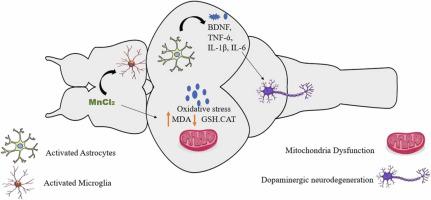Biomedicine & Pharmacotherapy ( IF 7.5 ) Pub Date : 2022-09-20 , DOI: 10.1016/j.biopha.2022.113697 Abhishek P R Nadig 1 , Bader Huwaimel 2 , Ahmed Alobaida 3 , El-Sayed Khafagy 4 , Hadil Faris Alotaibi 5 , Afrasim Moin 3 , Amr Selim Abu Lila 6 , Suman 7 , Sahyadri M 1 , K L Krishna 1

|
Parkinson’s disease (PD) is a progressive neurodegenerative disorder imposing a severe health and socioeconomic burden worldwide. Existing pharmacological approaches for developing PD are poorly developed and do not represent all the characteristics of disease pathology. Developing cost-effective, reliable Zebrafish (ZF) model will meet this gap. The present study was conceived to develop a reliable PD model in the ZF using manganese chloride (MnCl2). Here, we report that chronic exposure to 2 mM MnCl2 for 21 days produced non-motor and motor PD-like symptoms in adult ZF. Compared with control fish, MnCl2-treated fish showed reduced locomotory activity, indicating a deficit in motor function. In the light-dark box test, MnCl2-treated fish exhibited anxiety and depression-like behavior. MnCl2-treated fish exhibited a less olfactory preference for amino acids, indicating olfactory dysfunction. These behavioral symptoms were associated with decreased dopamine and increased DOPAC levels. Furthermore, oxidative stress-mediated apoptotic pathway, decreased brain derived neurotropic factor (BDNF) and increased pro-inflammatory cytokines levels were observed upon chronic exposure to MnCl2 in the brain of ZF. Thus, MnCl2-induced PD in ZF can be a cost-effective PD model in the drug discovery process. Moreover, this model could be potentially utilized to investigate the molecular pathways underlying the multifaceted pathophysiology which leads to PD using relatively inexpensive species. MnCl2 being heavy metal may have other side effects in addition to neurotoxicity. Our model recapitulates most of the hallmarks of PD, but not all pathological processes are involved. Future studies are required to recapitulate the complete pathophysiology of PD.
中文翻译:

氯化锰 (MnCl2) 诱导成年斑马鱼帕金森病的新模型;参与氧化应激、神经炎症和细胞凋亡途径
帕金森病 (PD) 是一种进行性神经退行性疾病,在全球范围内造成严重的健康和社会经济负担。用于发展 PD 的现有药理学方法发展不足,并且不能代表疾病病理学的所有特征。开发具有成本效益、可靠的斑马鱼 (ZF) 模型将填补这一空白。本研究旨在使用氯化锰 (MnCl 2 )在 ZF 中开发可靠的 PD 模型。在这里,我们报告慢性暴露于 2 mM MnCl 2 21 天会在成人 ZF 中产生非运动和运动 PD 样症状。与对照鱼相比,MnCl 2处理的鱼的运动活动减少,表明运动功能不足。在明暗盒测试中,MnCl 2处理过的鱼表现出焦虑和抑郁样行为。MnCl 2处理的鱼对氨基酸表现出较少的嗅觉偏好,表明嗅觉功能障碍。这些行为症状与多巴胺减少和 DOPAC 水平增加有关。此外,在 ZF 的大脑中长期暴露于 MnCl 2后,观察到氧化应激介导的细胞凋亡途径、脑源性神经营养因子 (BDNF) 减少和促炎细胞因子水平增加。因此,MnCl 2ZF 中诱导的 PD 可以成为药物发现过程中具有成本效益的 PD 模型。此外,该模型可潜在地用于研究使用相对便宜的物种导致 PD 的多方面病理生理学背后的分子途径。MnCl 2是重金属,除神经毒性外,可能还有其他副作用。我们的模型概括了 PD 的大部分特征,但并非涉及所有病理过程。需要未来的研究来概括 PD 的完整病理生理学。



























 京公网安备 11010802027423号
京公网安备 11010802027423号